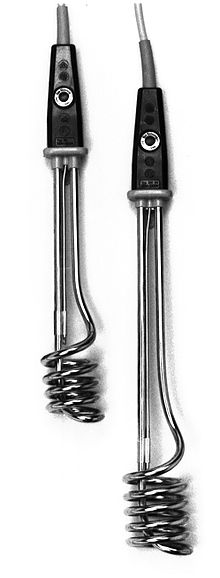Immersion heater
An immersion heater is a device for heating water with the help of electrical energy . The heated part of the immersion heater is immersed in the water to be heated.
construction
An immersion heater essentially consists of a tubular heating element that is connected to a plug via a cable. The protective tube of the tubular heater is usually made of nickel-plated or gold-plated brass , copper or stainless steel and, in most newer devices, is connected to the protective contact of the plug via the protective conductor of the connection line. The connection of the tubular heater to the cable is also designed as a heat-insulating handle.
Furthermore, an older design is known which has a sleeve-shaped heating element.
Older immersion heaters in particular do not have a protective conductor connection.
Historical and improvised immersion heaters that use the water itself as a heating conductor by means of electrodes also do not have a protective conductor connection, but at best a protective cage to prevent direct contact with the electrodes. See also Atomino .
Types and application
Immersion heaters are operated in a water bath. On the one hand, the water must cover the entire heating area of the tubular heater and, on the other hand, must not come too close to the electrical connections in the handle. There are often two markings (knurls) on the shaft of the heating element of the immersion heater, which indicate the maximum and minimum water level.
Small, so-called travel immersion heaters are either also designed for mains voltages of 230–250 V or 110–120 V or other voltages such as 12 V, 24 V or 48 V.
In the past, in some countries until today, there were immersion heaters with two electrodes that directly heated the water due to its conductivity. To do this, two electrodes connected directly to the mains voltage are immersed in the water. Depending on the design, these devices have a protective cage made of enamelled sheet metal around the electrodes in order to avoid direct contact or short circuits in containers made of conductive material. Although these immersion heaters offered safety in the case of boiling water, there was a risk of electric shock if the water or the metal pot were touched. In addition, the water was contaminated due to electrolysis and the thermal performance depended on the hardness of the water ( ionic conductivity ). For improvised devices of this type see also Atomino .
In contrast to the usual metal immersion heaters, there are also quartz glass immersion heaters for laboratory purposes , which can be operated for a longer period outside the liquid to be heated without being damaged. The quartz tube is an electrical insulator and resistant to acids, with the exception of hydrofluoric acid and phosphoric acid above 300 ° C . With quartz glass immersion heaters, other liquids can be heated in addition to water.
safety
Devices that used to be used without temperature protection posed a fire hazard if the water was boiled (unsupervised operation, e.g. even after a power cut) if the container or base was flammable. Immersion heaters should generally be operated in metal or ceramic vessels on a non-flammable surface. After use, the immersion heater should first cool down on a heat-resistant surface and not be put away while it is still hot.
Newer immersion heaters have overheating protection. There are two types:
- Simple immersion heaters are often provided with a non-resettable temperature fuse (melting element) in the heating element, after which the device can no longer be used.
- Immersion heaters with a resettable temperature fuse switch off if the water boils or if the pot / container has fallen over, but are ready for use again after cooling down and, if necessary, after resetting at the push of a button. On the outside, next to the heating element, you have a separate measuring sensor that monitors the temperature and triggers the switching mechanism in the handle if it overheats.
While the overheating protection with immersion heaters responds at significantly higher than the boiling temperature, kettles switch off exactly when boiling starts. They also have a second overheating protection, so there is redundant security. They are therefore preferred to immersion heaters today.
Efficiency comparison
Immersion heaters are very energy-efficient. The heating element is located directly in the water during operation. The heat loss occurs only through the surface of the water and pot and through the residual heat of the device. However, depending on the primary energy source , this is offset by a significantly poorer level of efficiency in generating the electricity used. In thermal power plants , this is only between 30 and 60%, depending on the design. Immersion heaters should therefore, like all electrical heating devices, be used cost-consciously. So only the amount of water that is needed should be heated.
The kettles in use today work according to the same principle, but are combined with a vessel and usually have a bimetal switch ( temperature switch ) that switches off the electricity when the boiling point is reached using the steam produced. If this switch fails, an additional, often non-resettable overtemperature protection ensures safe operation. However, kettles should not be left unattended. They are just as efficient as immersion heaters.
Many deep fryers , washing machines , samovars , dishwashers, and electric boilers have immersion heater-style heating elements.
The heating of water on a hotplate is significantly less efficient and therefore more expensive due to the heat capacity of the plate.
Heating water on the gas stove is associated with higher heat losses, but it is cheaper than electric heating.
Web links
Individual evidence
- ^ Walter Wittenberger: Chemical laboratory technology. 7th edition. Springer-Verlag, Vienna / New York 1973, ISBN 3-211-81116-8 , pp. 147-148.



